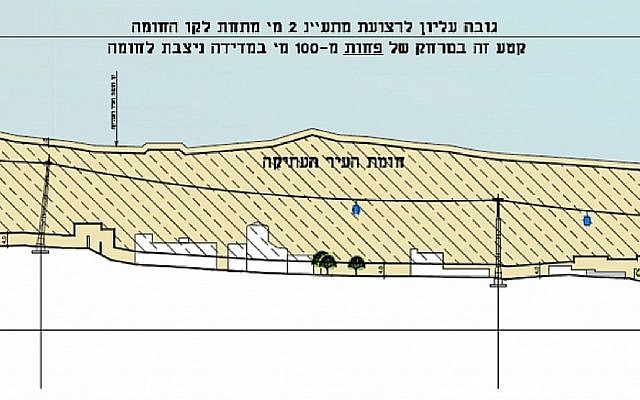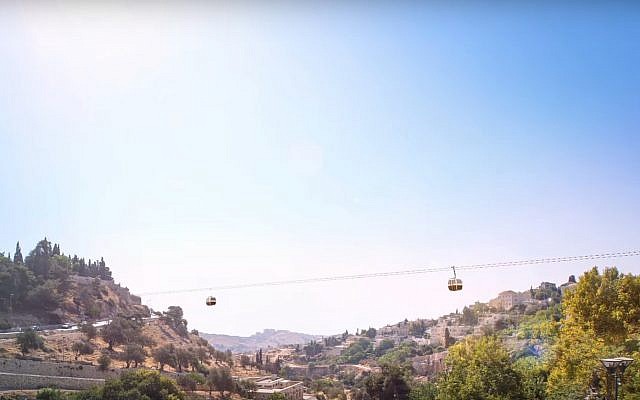Judge says court only intervenes when planning process is flawed; as legal opposition route closes, opponents of plan vow to launch public campaign
The High Court on Sunday rejected four petitions against a controversial plan to build a cable car to Jerusalem’s historic Old City, shutting down the legal opposition route for opponents of the plan.
Writing on behalf of a three-judge bench, Justice Yosef Elron said the court’s job was to intervene in planning decisions only if the planning could be proved to have been defective and the planners had reached decisions based on irrelevant considerations or acted beyond their briefs.
This was not the case with the planning of the cable car, Elron wrote.
Accusing the court of a political stance, the Emek Shaveh nonprofit, which has led the fight against the cable car, said the public campaign against it was “only just beginning.”
The left-wing organization, which works to keep antiquities open to all and to stop archaeology from being exploited for political ends, has long battled the powerful, private, right-wing City of David Foundation (known as Elad in Hebrew).
Elad is dedicated to maintaining a Jewish presence in the Old City Basin, and one of its biggest projects is slated to be the construction of a visitors’ center right outside of the Old City Walls, which will include the cable car station at the Dung Gate.

Eli Ben Ari, the legal adviser to Adam Teva V’Din, another of the petitioners against the plan, said the decision to build a cable car should not have been made without a thorough survey of other ancient cities. Such a survey would have shown that no other city would have dared to build a cable car so close to ancient city walls, he said.
Ben Ari added that insufficient attention had been paid to simpler, cheaper, and better ways of reducing traffic congestion around the Old City walls — the main stated aim of the cable car.
The petitioners also included store owners in the Old City together with residents of the Palestinian Silwan neighborhood, over which the cable car will pass, and the world Karaite community.
The latter claims that running a cable car over its cemetery on the southern slopes of the Hinnom Valley is tantamount to covering it over and placing it off-limits to community members, according to Karaite religious law.

The NIS 200 million (59 million) project, approved by the government in November 2019, calls for a 1.4-kilometer (nearly a mile) track running from the First Station shopping and entertainment area in West Jerusalem over a valley mainly populated by Palestinian East Jerusalemites to the Old City’s Dung Gate, near the Western Wall and the City of David archaeological site.
The cable cars will be strung over some 15 pylons, from nine to 26 meters (30 to 85 feet) high and visible from key points overlooking the Hinnom Valley.

There will be a middle station at Mount Zion and a storage depot for cabins in the neighborhood of Abu Tor.
The project’s advocates at the Tourism Ministry and Jerusalem Municipality argue that the cable car will attract tourists and relieve congestion around the Old City walls, and is the greenest, least disruptive, and most financially feasible way to get up to 3,000 visitors per hour from West Jerusalem to the Western Wall, the most venerated site where Jews may pray.
Its many opponents, however, say that the plan is obtrusive and culturally and politically irresponsible and that rather than solving the traffic problem, it will simply shift it to the area of the First Station.

Pulling the rug out from beneath the petitioners, Elron wrote that no defect had been found in the Tourism Ministry’s decision to refer the project to the National Infrastructure Committee, that this committee had been provided with sufficient facts, that the project met the definition both of a tourism and a transportation project, and that the Transportation Ministry had been sufficiently involved in the decisions.
The Tourism Ministry’s view that this was a real tourist attraction was sufficient, Elron said, adding: “It should be borne in mind that the court does not replace the discretion of the minister with its own discretion, but [only asks] whether the discretion deviates from the bounds of reasonableness.”
Elron and the other two justices, Alex Stein and Anat Baron, also found, contrary to the petitioners, that an adequate analysis of alternatives had been carried out.
In his ruling, Elron took no issue with a highly criticized traffic plan whose conclusions supported a cable car as being easier and quicker to implement than a light-rail alternative. He did not relate in any detail to the objections of the residents of Silwan and the store owners of the Old City.

On the Karaite community’s claims, Elron found no justification to intervene, noting that talks between the former and the Jerusalem Development Company had broken down, and called for them to be resumed.
The Jerusalem Development Company had offered both to move the cable car lines away from the active part of the cemetery, and to relocate affected graves at its expense, Elron wrote.
It was important to balance the interest of protecting the honor of the dead with the public interest inherent in realizing the plan, Elron wrote, concluding that with no “practical possibility” of moving the line even further than offered, and with no damage expected to the graves themselves, the balance struck by the government and the National Infrastructure Committee was “proper and proportionate.”
Elron said the petitioners’ central claim that a cable car was inappropriate to the landscape and environment around the Old City was understandable.
“This is a complex issue,” he wrote, “requiring a delicate balance between a wide range of considerations.”
But it was clear that any solution to the problem — from adding more shuttle buses to doing nothing at all — would exact some kind of price. There was “no perfect solution,” and the planning authorities, aware of the difficulties, had still decided to approve the cable car, he found.


